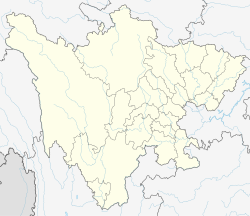
Back Butuo Xian CEB Butuo German شهرستان بوتوو Persian Xian de Butuo French Pu-thô-yen HAK Contea di Butuo Italian 布拖県 Japanese 부퉈현 Korean Butuo NB Буто (Ляншань) Russian
Butuo County
布拖县 · ꀭꄮꑤ | |
|---|---|
 Location of Butuo County (pink) and Liangshan Prefecture (yellow) within Sichuan | |
| Coordinates: 27°36′N 102°52′E / 27.600°N 102.867°E | |
| Country | China |
| Province | Sichuan |
| Autonomous prefecture | Liangshan |
| County seat | Temuli |
| Area | |
| • Total | 1,685 km2 (651 sq mi) |
| Elevation | 2,398 m (7,867 ft) |
| Highest elevation | 3,891 m (12,766 ft) |
| Lowest elevation | 535 m (1,755 ft) |
| Population (2020)[1] | |
| • Total | 185,553 |
| • Density | 110/km2 (290/sq mi) |
| Time zone | UTC+8 (China Standard) |
| Website | www |
| Butuo County | |||||||
|---|---|---|---|---|---|---|---|
| Chinese name | |||||||
| Simplified Chinese | 布拖县 | ||||||
| Traditional Chinese | 布拖縣 | ||||||
| |||||||
| Yi name | |||||||
| Yi | ꀭꄮꑤ Romanisation: bux te xiep | ||||||
Butuo County (Chinese: 布拖县, Yi: ꀭꄮꑤ) is a county of southern Sichuan Province, China. It is under the administration of the Liangshan Yi Autonomous Prefecture. It was incorporated in 1952,[2][additional citation(s) needed] and has continuously existed since 1960. The name 'Butou' is based on the Yi language words for hedgehog and pine tree, giving it the name "a place with hedgehogs and pine trees". It is the unofficial capital of the Yi People and the birthplace of the Torch Festival.[3] The county has a population of 215,800, 97.2% of whom are Yi People.[4]
Butuo is considered very impoverished, traditional and still significantly influenced by the legacy of feudalism and slavery, which was only reformed in the 1950s.[5] Most villagers make a living through animal husbandry. Almost all of the non-agrarian economy is concentrated in the county seat.[2] It is a 'key county' for National Poverty Alleviation and Development work, with as of 2018, 122 poverty-stricken designated villages in the county, and 57,000 poor people.[6]
The bamboo mouth harp (Kouxian) of Butou County was included as intangible cultural heritage of the Yi People.[7]
- ^ "凉山州第七次全国人口普查公报(第二号)——县(市)人口情况" (in Chinese). Government of Liangshan Prefecture. 2021-06-02. Archived from the original on 2022-06-12. Retrieved 2023-08-09.
- ^ a b Thomas Heberer (1 September 2012). Doing Business in Rural China: Liangshan's New Ethnic Entrepreneurs. University of Washington Press. p. 58. ISBN 978-0-295-80409-5.
- ^ "历史沿革". www.bt.gov.cn.
- ^ "布拖概况". www.bt.gov.cn.
- ^ Hill, Ann Maxwell (2001). "Captives, Kin, and Slaves in Xiao Liangshan". The Journal of Asian Studies. 60 (4): 1033–1049. doi:10.2307/2700019. JSTOR 2700019. S2CID 145130654 – via JSTOR.
- ^ "【脱贫攻坚在凉山】布拖县亚河村:解锁脱贫致富新模式" [[Tackling poverty in Liangshan] Yahe Village in Butuo County: Unlocking a new model of poverty alleviation]. news.cctv.com.
- ^ Keith Howard (29 April 2016). Music as Intangible Cultural Heritage: Policy, Ideology, and Practice in the Preservation of East Asian Traditions. Taylor & Francis. p. 137. ISBN 978-1-317-09216-2.
© MMXXIII Rich X Search. We shall prevail. All rights reserved. Rich X Search

